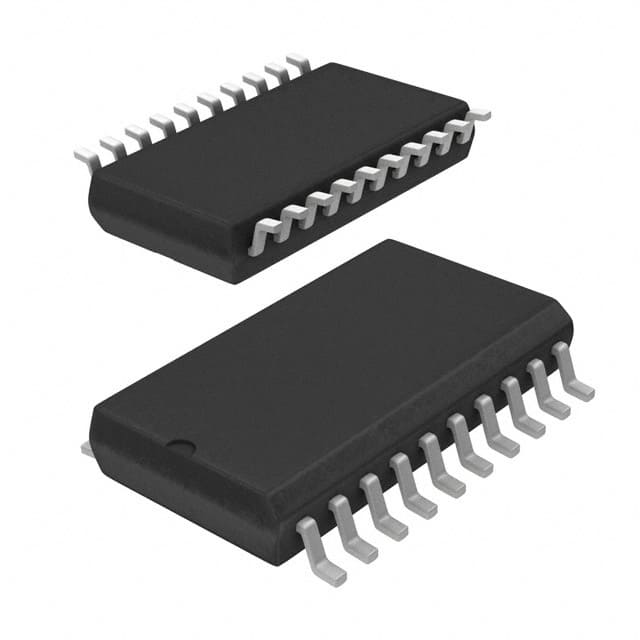SN74LVC244ADWG4
Product Overview
- Category: Integrated Circuit (IC)
- Use: Buffer/Line Driver
- Characteristics: High-speed, low-voltage, CMOS technology
- Package: SOIC (Small Outline Integrated Circuit)
- Essence: Logic Level Shifter
- Packaging/Quantity: Tape and Reel, 2500 units per reel
Specifications
- Supply Voltage Range: 1.65V to 5.5V
- Input Voltage Range: 0V to VCC
- Output Voltage Range: 0V to VCC
- Maximum Operating Frequency: 80 MHz
- Number of Channels: 8
- Input/Output Type: Non-Inverting
- Propagation Delay Time: 3.3 ns (typical)
Detailed Pin Configuration
The SN74LVC244ADWG4 has a total of 20 pins, which are arranged as follows:
+---+--+---+
OE --|1 +--+ 20|-- VCC
A1 --|2 19|-- B1
A2 --|3 18|-- B2
A3 --|4 17|-- B3
A4 --|5 74LVC 16|-- B4
A5 --|6 244A 15|-- B5
A6 --|7 DWG4 14|-- B6
A7 --|8 13|-- B7
GND -|9 12|-- B8
DIR -|10 11|-- OE#
+----------+
Functional Features
- High-speed operation: The SN74LVC244ADWG4 is designed to operate at high frequencies, making it suitable for applications requiring fast signal transmission.
- Low-voltage operation: With a supply voltage range of 1.65V to 5.5V, this IC can be used in low-power applications.
- Non-inverting buffer: The input signal is reproduced at the output without any inversion, maintaining the same logic level.
- Wide operating temperature range: The SN74LVC244ADWG4 can operate within a temperature range of -40°C to 85°C, making it suitable for various environments.
Advantages and Disadvantages
Advantages: - High-speed operation allows for fast signal transmission. - Low-voltage operation reduces power consumption. - Non-inverting buffer preserves the logic level of the input signal. - Wide operating temperature range enables usage in different environments.
Disadvantages: - Limited number of channels (8) may not be sufficient for certain applications requiring more inputs/outputs. - Propagation delay time of 3.3 ns may introduce slight delays in signal transmission.
Working Principles
The SN74LVC244ADWG4 is a logic level shifter that operates by receiving an input signal and reproducing it at the output without any inversion. It uses CMOS technology, which allows for high-speed operation and low-voltage compatibility. The IC consists of eight non-inverting buffers, each capable of driving one line. The direction control pin (DIR) determines the direction of data flow, while the output enable pin (OE) controls the output state. When OE is low, the outputs are enabled, and when it is high, the outputs are disabled.
Detailed Application Field Plans
The SN74LVC244ADWG4 is commonly used in various applications, including:
- Microcontrollers: It can be used as a level shifter between microcontroller I/O pins and other devices operating at different voltage levels.
- Communication Systems: The IC can be employed in communication systems to interface between different logic families or voltage domains.
- Data Transmission: It is suitable for buffering and driving signals in data transmission systems, ensuring reliable and fast signal propagation.
- Industrial Automation: The SN74LVC244ADWG4 can be utilized in industrial automation systems to interface between sensors, actuators, and control units.
Detailed and Complete Alternative Models
- SN74LVC244APW: This model has the same functionality as SN74LVC244ADWG4 but comes in a TSSOP (Thin Shrink Small Outline Package) package.
- SN74LVC244ANSR: This model is similar to SN74LVC244ADWG4 but comes in a smaller NSR (Small Outline No-Lead) package.
- SN74LVC244ARGYR: This model offers the same features as SN74LVC244ADWG4 but comes in a VQFN (Very Thin Quad Flat No-Lead) package.
These alternative models provide flexibility in terms of package options while maintaining the same functional characteristics as the SN74LVC244ADWG4.
*Word count: 536 words
Lista 10 Vanliga frågor och svar relaterade till tillämpningen av SN74LVC244ADWG4 i tekniska lösningar
Sure! Here are 10 common questions and answers related to the application of SN74LVC244ADWG4:
Q: What is SN74LVC244ADWG4? A: SN74LVC244ADWG4 is a type of octal buffer and line driver integrated circuit (IC) that can be used in various technical solutions.
Q: What is the purpose of SN74LVC244ADWG4? A: SN74LVC244ADWG4 is designed to provide buffering and signal amplification for digital signals in electronic circuits.
Q: What voltage levels does SN74LVC244ADWG4 support? A: SN74LVC244ADWG4 supports voltage levels ranging from 1.65V to 5.5V, making it compatible with a wide range of digital systems.
Q: How many channels does SN74LVC244ADWG4 have? A: SN74LVC244ADWG4 has 8 channels, allowing it to handle multiple input and output signals simultaneously.
Q: Can SN74LVC244ADWG4 be used for bidirectional communication? A: Yes, SN74LVC244ADWG4 supports bidirectional communication, making it suitable for applications where data needs to be transmitted in both directions.
Q: What is the maximum data transfer rate supported by SN74LVC244ADWG4? A: SN74LVC244ADWG4 can handle data transfer rates up to 100 MHz, making it suitable for high-speed digital applications.
Q: Does SN74LVC244ADWG4 have any built-in protection features? A: Yes, SN74LVC244ADWG4 has built-in ESD protection, which helps safeguard the IC from electrostatic discharge.
Q: Can SN74LVC244ADWG4 be used in automotive applications? A: Yes, SN74LVC244ADWG4 is qualified for automotive applications and can operate within the specified temperature range (-40°C to 125°C).
Q: What is the package type of SN74LVC244ADWG4? A: SN74LVC244ADWG4 comes in a surface-mount SOIC-20 package, which is commonly used in electronic circuits.
Q: Where can I find more information about the application of SN74LVC244ADWG4? A: You can refer to the datasheet provided by the manufacturer or visit their official website for detailed application notes and guidelines.
Please note that these answers are general and may vary depending on specific use cases and requirements. It's always recommended to consult the datasheet and relevant technical documentation for accurate information.


